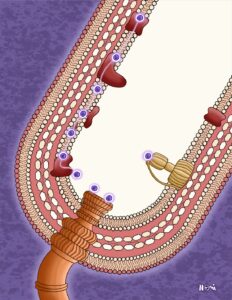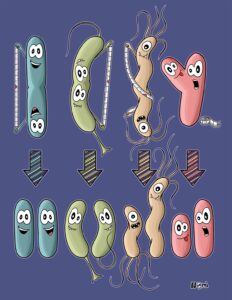When scientists first used microscopes to look at microorganisms and bacteria, they did not know what they were seeing. They could only describe the shapes of these tiny organisms.
So, they talked of cocci and bacilli based on the spheres and rods that they saw under the microscope.
And they classified microbes and bacteria based on these shapes.
It came only with later, modern technologies that scientists learned that there was more to bacteria than their shapes. Even though bacteria looked similar, they had different superpowers.
Yet, some of these bacterial superpowers are indeed influenced by their cell shapes.
So, what is it about bacterial shapes? Why do bacteria look differently? And how do the different shapes of bacteria help them survive and thrive?
What gives bacteria their shapes?
To protect themselves from the environment, bacteria as well as all other organisms have cell envelopes. These keep the cellular machines and internal parts together so that a bacterium can function within this envelope.
And this envelope also gives bacteria their shape.
Both Gram-positive and Gram-negative bacteria have a layer of so-called peptidoglycan within their envelope. This peptidoglycan layer is made of sugars that are linked together by very strong bonds. This is why the peptidoglycan layer is pretty rigid and stiff and has a specific shape in each bacterium.

Either on the inside or on the outside, the peptidoglycan layer is linked to the cellular membranes. Together, these make up the bacterial envelope with a specific cell shape.
What different shapes do bacteria have?
Microbiologists have different ways to classify known bacterial shapes. Here, I will introduce you to the bacterial shapes according to what makes the most sense to me.
Rod-shaped bacteria
As the name suggests, these bacteria have a rod or cylindrical shape. Examples of rod-shaped bacteria are Escherichia coli and Bacillus subtilis.
Scientists are also convinced that rod-shaped bacteria are the evolutionary ancestors of all other bacterial shapes.
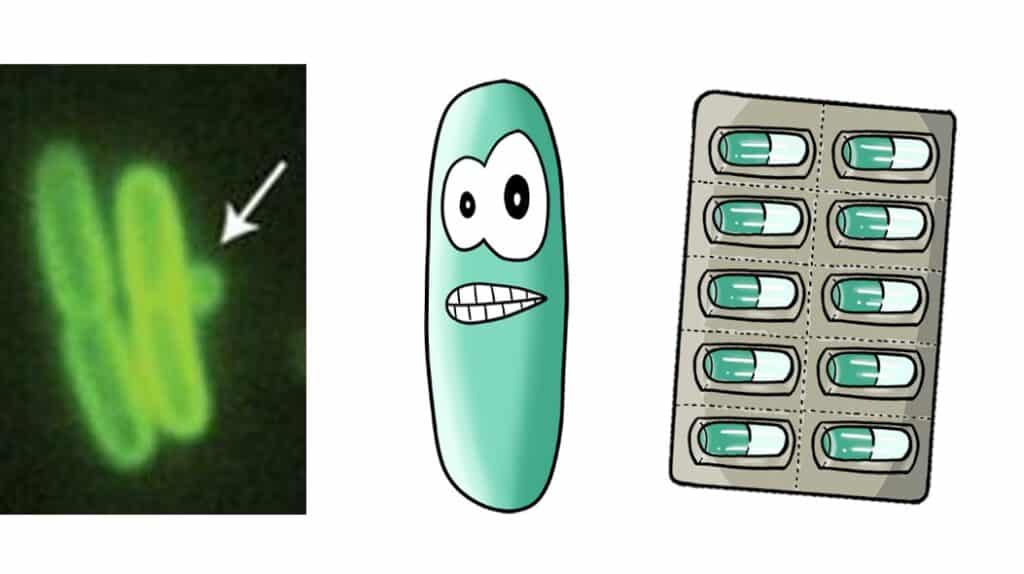
The shape comes from proteins that form long cables within the bacterial cell. These span out the whole bacterium from one end to the other.
Rod-shaped bacteria grow by two modes that we talk about in Why bacteria divide into two and grow with the help of a strong ring: First, they extend their cell size by growing the peptidoglycan, the cable proteins and the membrane.
Second, the cable proteins determine the middle of the cell, where the bacterium produces a special ring. Eventually, this ring narrows so that the bacterium divides and two bacterial cells form.
Spherical bacteria
The spherical bacteria – or so-called cocci – include many pathogenic bacteria like Staphylococcus aureus, Streptococcus pneumoniae and Neisseria gonorrhoeae.
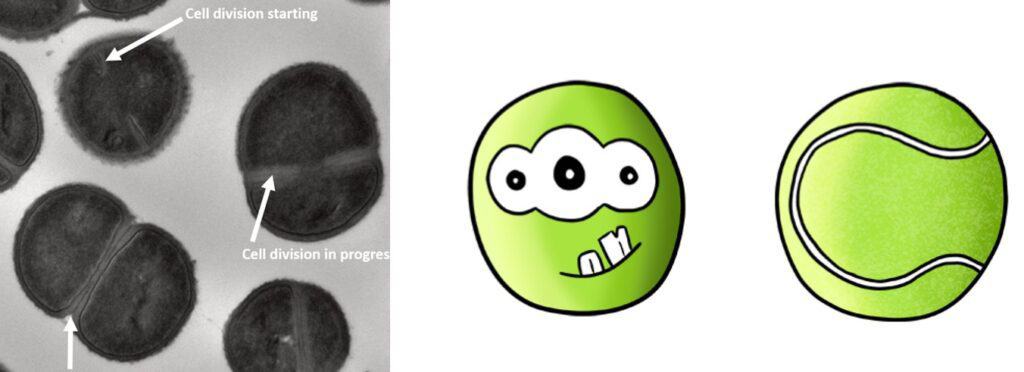
Microbiologists think that spherical bacteria were once rod-shaped as well. However, spherical bacteria do not have these long cable proteins that extend their cell bodies. Thus, they stay spherical and grow by dividing their spherical cells right in the middle.
However, sometimes the two daughter cells do not completely divide and they stay attached to each other. This is why some spherical bacteria live as so-called diplococci.
Curved bacteria
Curved bacteria have the shape of a comma or banana and are sometimes also slightly twisted. Examples of curved or banana-shaped bacteria are Caulobacter crescentus and Vibrio cholerae.
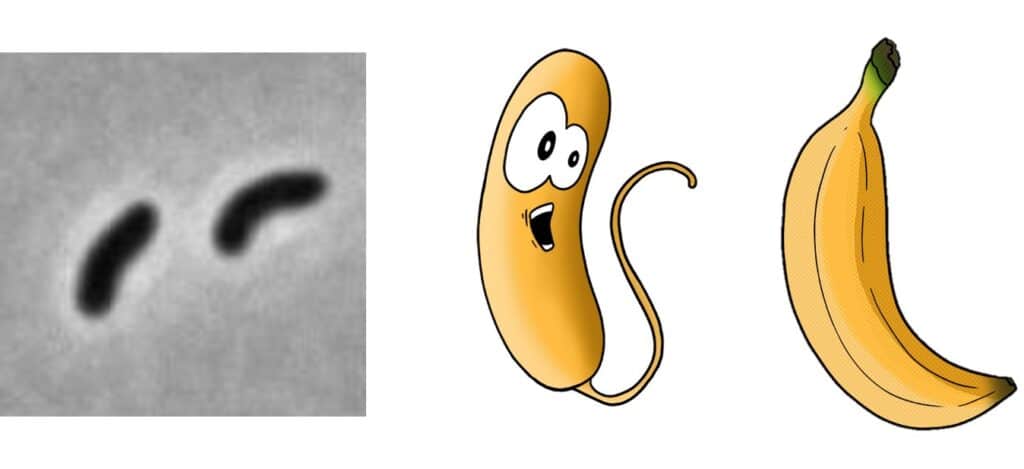
These curved bacteria usually live in watery environments where there are flows. Here, the curved shape helps the bacteria to align with the flow while staying attached to a surface.
In the case of Caulobacter crescentus, one end of the bacterium is glued to a surface with a strong super glue. When this bacterium divides in the middle, one daughter cell remains attached to the surface, while the other one can swim away and find a new location to settle down.
Spiral bacteria
Spiral bacteria are a mix of rods and curves which give them a helical twist. Hence, these bacteria have a corkscrew shape.
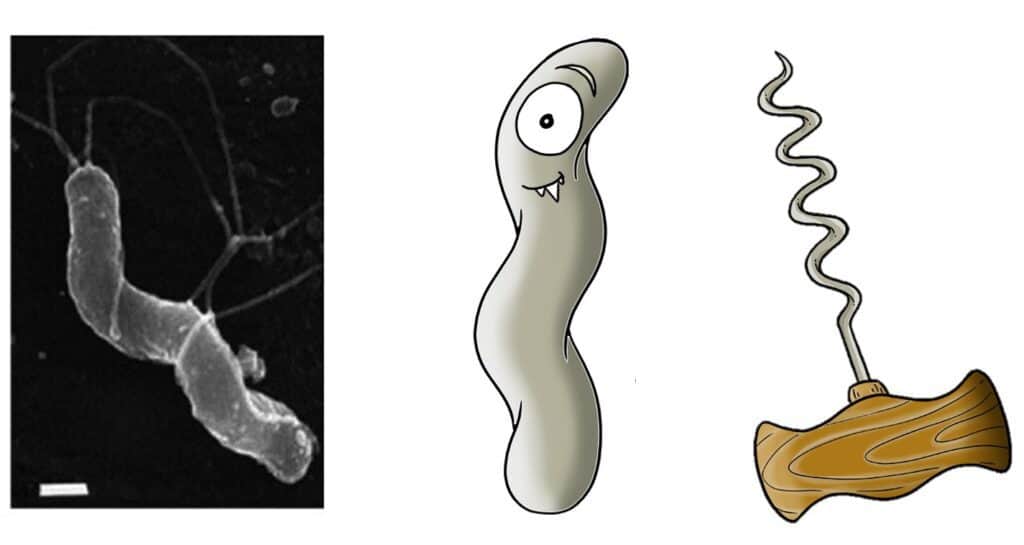
Many pathogenic bacteria use their corkscrew shape to swim through gel-like solutions. This includes Helicobacter pylori and Campylobacter jejuni.
Since spiral – or helical – bacteria are also thinner, they can reach locations that are too narrow for other bacteria to reach. They also use their flagella to push themselves forward and “wriggle” through narrow pores.
Star-shaped bacteria
Some bacteria look even fancier than others: They are real stars – yes, bacteria with a star shape.
While we don’t know much yet about star-shaped bacteria, they belong to the so-called Stella species or are Methylomirabilis oxyfera. These usually grow in freshwater, soil and sewage.
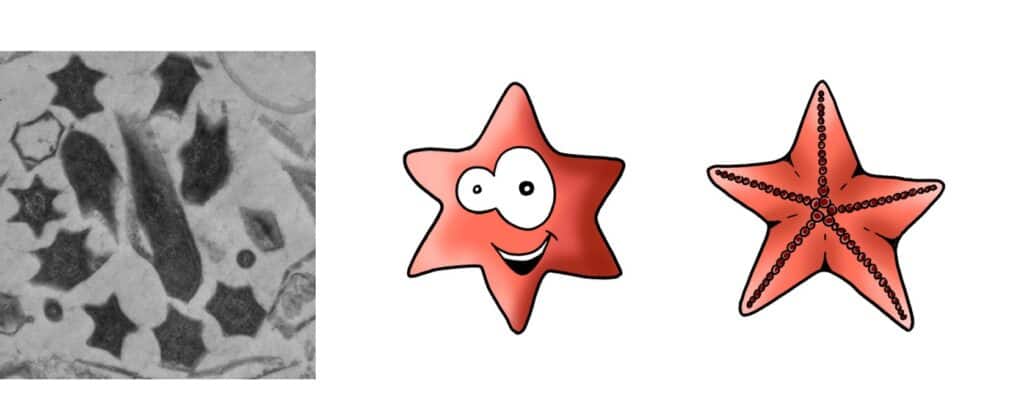
The star shape comes from six little arms that extend out of the bacterial cell. These push and grow to the outside giving these bacteria a shiny star shape.
Why do bacteria have different shapes?
Now that we have seen the different shapes of bacteria, you might ask yourself, why do bacteria have these different shapes? How do they help them?
As always in biology, it comes down to how a property helps a bacterium survive in a certain location. Often, the cell shape gives a bacterium advantages over other bacteria and it is easier for them to settle down and face harsh environments.
For example, spherical cells have the lowest surface-to-volume ratio. This means they have a large envelope surface through which they can take up a lot of nutrients. All this while their cell volume is relatively small. So they don’t actually need that many nutrients. This helps cocci to grow in locations where there are little amounts of nutrients.
On the other hand, rod-shaped bacteria often have flagella. And thanks to their shapes, they are efficient swimmers. This allows them to swim to new places in cases of danger or the lack of nutrients.
Bacterial cell shapes help face harsh environments
Also, straight rod cells can pack into biofilms more efficiently and build organised structures. This helps them colonise different locations and resist dangerous environments.
Many rod-shaped bacteria also form longer filamentous organisms. These stronger and larger structures protect bacteria from being eaten by other organisms. Another advantage of these multicellular organisms is that they allow more cells to attach to surfaces and colonise hosts.
Lastly, both curved and helical bacteria use their shapes to get better around their environments. Curved bacteria grow in watery environments but also in our guts. Here, their shapes help them align with the flow of water or our gut content while they stay attached to a surface or the gut wall. This keeps them at their preferred location and protects them from being flushed away.
Spiral bacteria use a fascinating helical movement to screw through gel-like or viscous fluids. This for example helps pathogens swim through the mucus of our stomach and guts and colonise us and make us sick.
Bacteria and their shapes
Here, we looked at the different shapes that bacteria have and how these help them survive. Bacteria always face harsh and new environments and conditions and only survive if they have the right tools or means.
So, by adapting their shapes, bacteria often have advantages over other bacteria. Plus, they look cool and fabulous!



